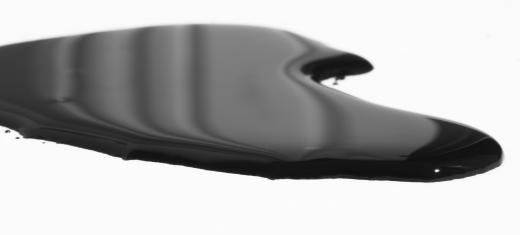Visbreaking refers to the process of reducing the viscosity of a liquid through high temperatures. This is a type of thermal cracking that works by breaking the molecular bonds of the liquid. Big molecules that made up the liquid are "cracked" into smaller molecules. This enables the molecules to flow easier, reducing the liquid's viscosity. There are two general technologies used for inducing visbreak: coil and soaker.
The term visbreaking comes from the words "viscosity" and "breaking." It is a non-catalytic process, which means that a catalyst is not used to lower the temperature at which the cracking takes place. Pre-heated air is instead injected into the furnace to quickly increase the temperature.

A coil visbreaker uses a furnace tube called a coil to heat the feed stream. In the oil industry, feed or feed stream refers to crude oil. The temperature and speed of the furnace is mostly controlled through the feed stream and the flow of air in the furnace.
In soaker visbreaking, the feed needs a relatively low temperature but a long processing time for cracking. The heated feed soaks in the visbreaking unit, called a drum. It then transfers to a fractionator, which separates the feed into several byproducts. The lower temperature uses less energy and reduces the amount of residue in the process.

Some visbreaking units utilize the properties of both processes by combining them. The initial cracking takes place in the furnace tube where much of the feed is heated. The feed then passes through a quencher to reduce its temperature. After the feed is quenched, it soaks in a drum for further cracking.
Quenching the feed slows the production of coke, a low value product. A slow coke production leads to less decoking, which usually saves time and cost. The coke that accumulates in the drum is often recycled in the feed.

The oil industry developed visbreaking to produce petroleum products. When oils are first dug up, they are in an unrefined state. This is where the term "crude oil" originated. Oil refineries use the visbreaking process to convert this crude oil into several final products.
Products from the crude oil are commonly divided into three categories: gas distillates, middle distillates, and residues. Middle distillates are more valuable compared to other byproducts. Gas distillates and residues, while not as valuable, still have industrial uses.
A visbreaker unit typically aims to increase the amount of middle distillate. Gasoline and petroleum are two of the most valuable middle distillate byproducts made from crude oil. By increasing the amount of middle distillates in the feed stream, the oil refinery increases its profits.
Residues from the visbreaking process include tar and coke. They are used for different purposes like roofing and manufacture of dry cells. Gas distillates such as LPG are commonly sold as fuel for household use.
